The Impact of Diversity on Creativity and Innovation in the Workplace
VerifiedAdded on 2021/11/11
|8
|2157
|113
Report
AI Summary
This report provides an annotated bibliography exploring the impact of diversity on creativity and innovation in the workplace. It analyzes five articles, focusing on cultural and demographic diversity and their effects on organizational performance, employee creativity, and innovation. The report discusses how diverse teams and cross-cultural interactions can foster creativity, improve communication, and drive innovation. The analysis includes studies on the benefits of diverse workforces, the role of management in promoting innovation, and the challenges related to communication within diverse teams. The findings emphasize the importance of embracing diversity to gain a competitive advantage and enhance overall organizational success. The report also references key models and theories, such as the Categorization-Elaboration Model, to explain the dynamics of diverse teams and their impact on innovation.
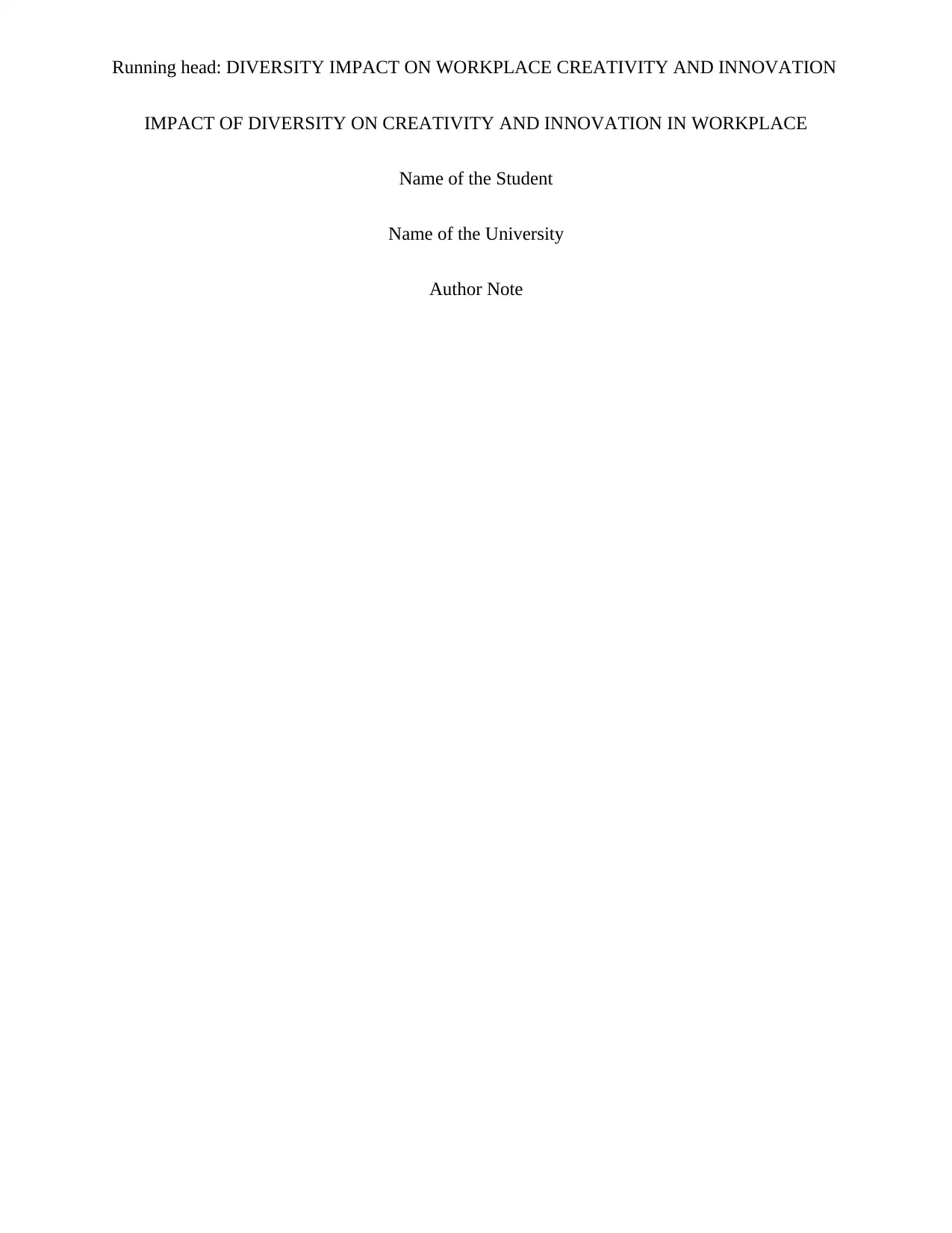
Running head: DIVERSITY IMPACT ON WORKPLACE CREATIVITY AND INNOVATION
IMPACT OF DIVERSITY ON CREATIVITY AND INNOVATION IN WORKPLACE
Name of the Student
Name of the University
Author Note
IMPACT OF DIVERSITY ON CREATIVITY AND INNOVATION IN WORKPLACE
Name of the Student
Name of the University
Author Note
Paraphrase This Document
Need a fresh take? Get an instant paraphrase of this document with our AI Paraphraser
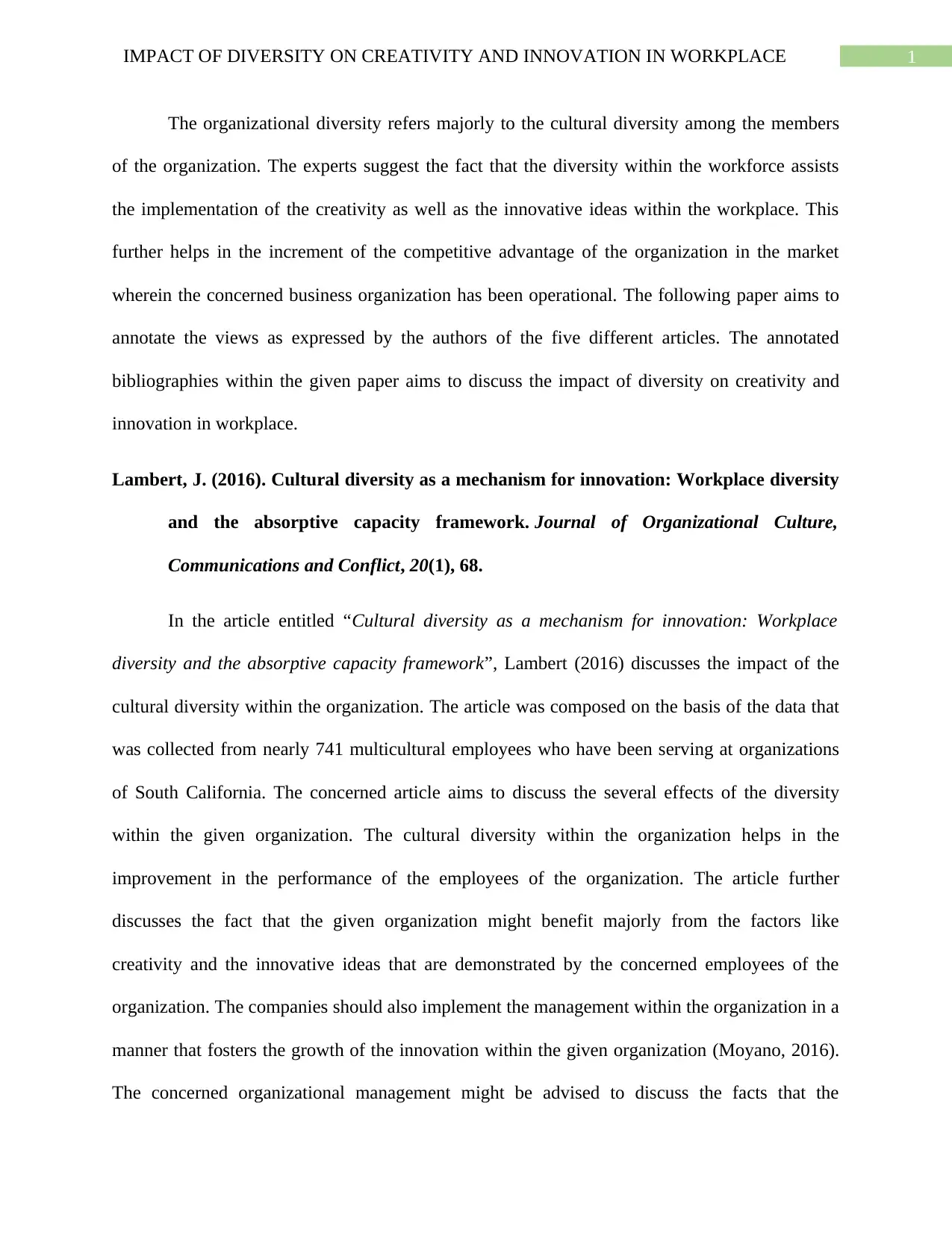
1IMPACT OF DIVERSITY ON CREATIVITY AND INNOVATION IN WORKPLACE
The organizational diversity refers majorly to the cultural diversity among the members
of the organization. The experts suggest the fact that the diversity within the workforce assists
the implementation of the creativity as well as the innovative ideas within the workplace. This
further helps in the increment of the competitive advantage of the organization in the market
wherein the concerned business organization has been operational. The following paper aims to
annotate the views as expressed by the authors of the five different articles. The annotated
bibliographies within the given paper aims to discuss the impact of diversity on creativity and
innovation in workplace.
Lambert, J. (2016). Cultural diversity as a mechanism for innovation: Workplace diversity
and the absorptive capacity framework. Journal of Organizational Culture,
Communications and Conflict, 20(1), 68.
In the article entitled “Cultural diversity as a mechanism for innovation: Workplace
diversity and the absorptive capacity framework”, Lambert (2016) discusses the impact of the
cultural diversity within the organization. The article was composed on the basis of the data that
was collected from nearly 741 multicultural employees who have been serving at organizations
of South California. The concerned article aims to discuss the several effects of the diversity
within the given organization. The cultural diversity within the organization helps in the
improvement in the performance of the employees of the organization. The article further
discusses the fact that the given organization might benefit majorly from the factors like
creativity and the innovative ideas that are demonstrated by the concerned employees of the
organization. The companies should also implement the management within the organization in a
manner that fosters the growth of the innovation within the given organization (Moyano, 2016).
The concerned organizational management might be advised to discuss the facts that the
The organizational diversity refers majorly to the cultural diversity among the members
of the organization. The experts suggest the fact that the diversity within the workforce assists
the implementation of the creativity as well as the innovative ideas within the workplace. This
further helps in the increment of the competitive advantage of the organization in the market
wherein the concerned business organization has been operational. The following paper aims to
annotate the views as expressed by the authors of the five different articles. The annotated
bibliographies within the given paper aims to discuss the impact of diversity on creativity and
innovation in workplace.
Lambert, J. (2016). Cultural diversity as a mechanism for innovation: Workplace diversity
and the absorptive capacity framework. Journal of Organizational Culture,
Communications and Conflict, 20(1), 68.
In the article entitled “Cultural diversity as a mechanism for innovation: Workplace
diversity and the absorptive capacity framework”, Lambert (2016) discusses the impact of the
cultural diversity within the organization. The article was composed on the basis of the data that
was collected from nearly 741 multicultural employees who have been serving at organizations
of South California. The concerned article aims to discuss the several effects of the diversity
within the given organization. The cultural diversity within the organization helps in the
improvement in the performance of the employees of the organization. The article further
discusses the fact that the given organization might benefit majorly from the factors like
creativity and the innovative ideas that are demonstrated by the concerned employees of the
organization. The companies should also implement the management within the organization in a
manner that fosters the growth of the innovation within the given organization (Moyano, 2016).
The concerned organizational management might be advised to discuss the facts that the
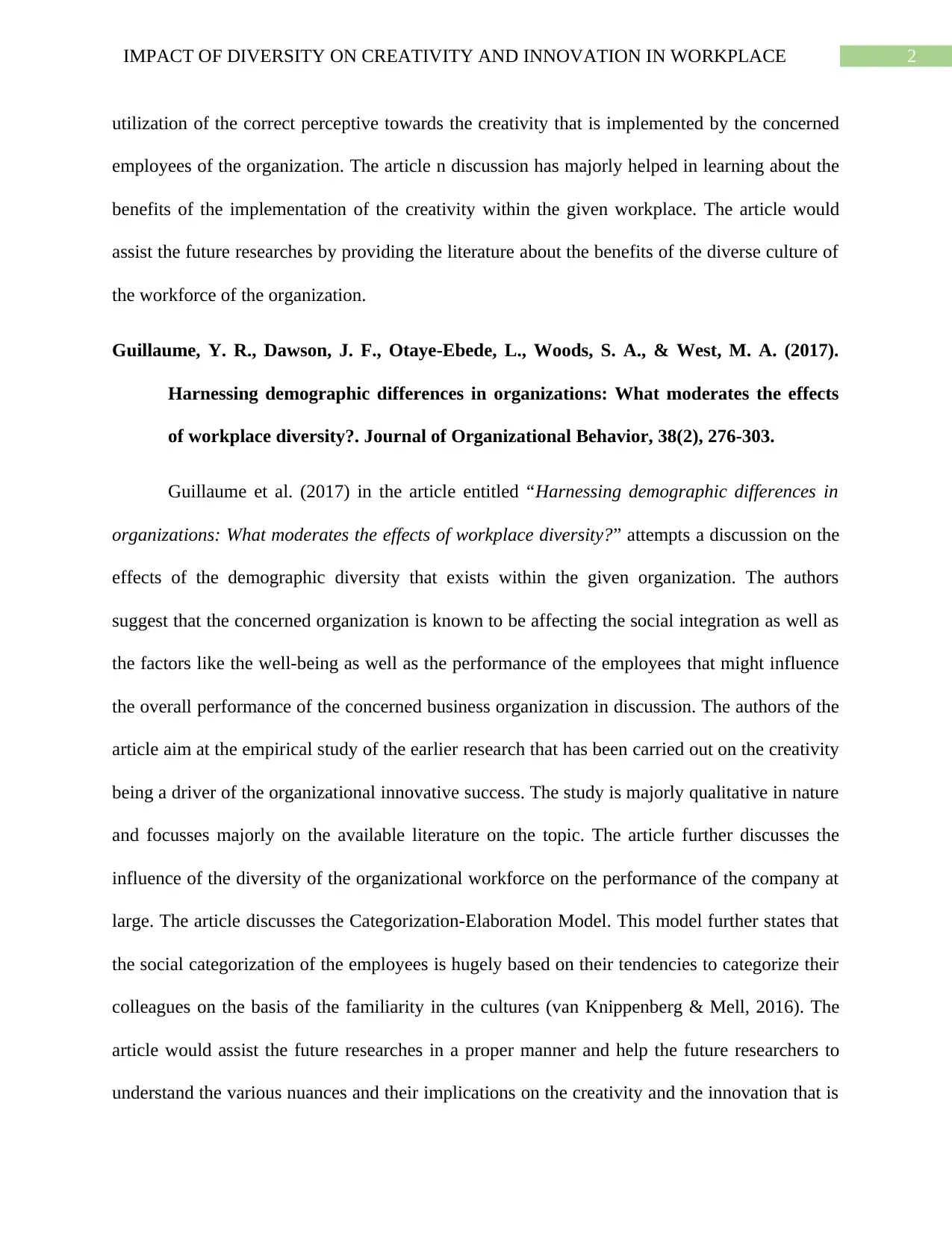
2IMPACT OF DIVERSITY ON CREATIVITY AND INNOVATION IN WORKPLACE
utilization of the correct perceptive towards the creativity that is implemented by the concerned
employees of the organization. The article n discussion has majorly helped in learning about the
benefits of the implementation of the creativity within the given workplace. The article would
assist the future researches by providing the literature about the benefits of the diverse culture of
the workforce of the organization.
Guillaume, Y. R., Dawson, J. F., Otaye‐Ebede, L., Woods, S. A., & West, M. A. (2017).
Harnessing demographic differences in organizations: What moderates the effects
of workplace diversity?. Journal of Organizational Behavior, 38(2), 276-303.
Guillaume et al. (2017) in the article entitled “Harnessing demographic differences in
organizations: What moderates the effects of workplace diversity?” attempts a discussion on the
effects of the demographic diversity that exists within the given organization. The authors
suggest that the concerned organization is known to be affecting the social integration as well as
the factors like the well-being as well as the performance of the employees that might influence
the overall performance of the concerned business organization in discussion. The authors of the
article aim at the empirical study of the earlier research that has been carried out on the creativity
being a driver of the organizational innovative success. The study is majorly qualitative in nature
and focusses majorly on the available literature on the topic. The article further discusses the
influence of the diversity of the organizational workforce on the performance of the company at
large. The article discusses the Categorization-Elaboration Model. This model further states that
the social categorization of the employees is hugely based on their tendencies to categorize their
colleagues on the basis of the familiarity in the cultures (van Knippenberg & Mell, 2016). The
article would assist the future researches in a proper manner and help the future researchers to
understand the various nuances and their implications on the creativity and the innovation that is
utilization of the correct perceptive towards the creativity that is implemented by the concerned
employees of the organization. The article n discussion has majorly helped in learning about the
benefits of the implementation of the creativity within the given workplace. The article would
assist the future researches by providing the literature about the benefits of the diverse culture of
the workforce of the organization.
Guillaume, Y. R., Dawson, J. F., Otaye‐Ebede, L., Woods, S. A., & West, M. A. (2017).
Harnessing demographic differences in organizations: What moderates the effects
of workplace diversity?. Journal of Organizational Behavior, 38(2), 276-303.
Guillaume et al. (2017) in the article entitled “Harnessing demographic differences in
organizations: What moderates the effects of workplace diversity?” attempts a discussion on the
effects of the demographic diversity that exists within the given organization. The authors
suggest that the concerned organization is known to be affecting the social integration as well as
the factors like the well-being as well as the performance of the employees that might influence
the overall performance of the concerned business organization in discussion. The authors of the
article aim at the empirical study of the earlier research that has been carried out on the creativity
being a driver of the organizational innovative success. The study is majorly qualitative in nature
and focusses majorly on the available literature on the topic. The article further discusses the
influence of the diversity of the organizational workforce on the performance of the company at
large. The article discusses the Categorization-Elaboration Model. This model further states that
the social categorization of the employees is hugely based on their tendencies to categorize their
colleagues on the basis of the familiarity in the cultures (van Knippenberg & Mell, 2016). The
article would assist the future researches in a proper manner and help the future researchers to
understand the various nuances and their implications on the creativity and the innovation that is
⊘ This is a preview!⊘
Do you want full access?
Subscribe today to unlock all pages.

Trusted by 1+ million students worldwide
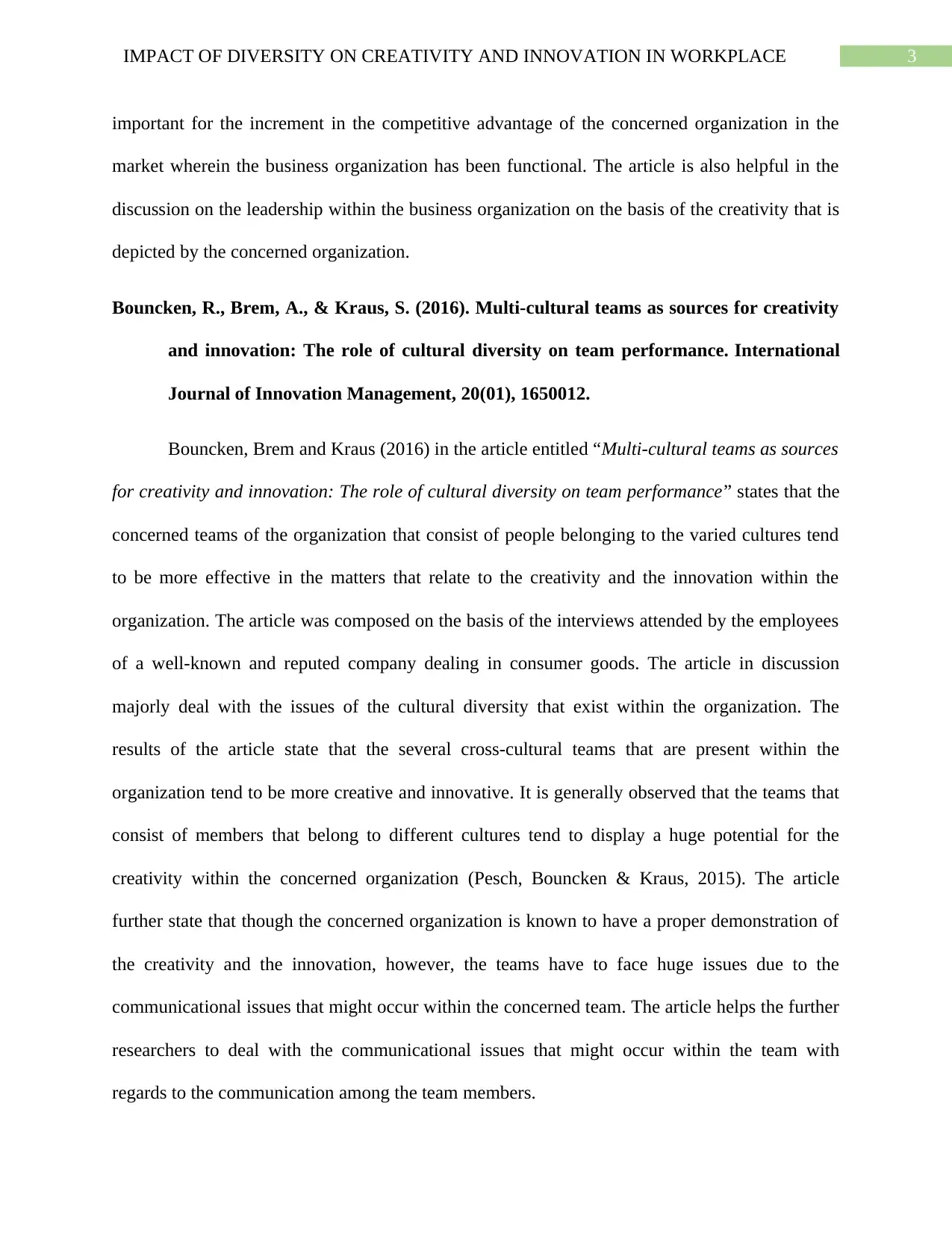
3IMPACT OF DIVERSITY ON CREATIVITY AND INNOVATION IN WORKPLACE
important for the increment in the competitive advantage of the concerned organization in the
market wherein the business organization has been functional. The article is also helpful in the
discussion on the leadership within the business organization on the basis of the creativity that is
depicted by the concerned organization.
Bouncken, R., Brem, A., & Kraus, S. (2016). Multi-cultural teams as sources for creativity
and innovation: The role of cultural diversity on team performance. International
Journal of Innovation Management, 20(01), 1650012.
Bouncken, Brem and Kraus (2016) in the article entitled “Multi-cultural teams as sources
for creativity and innovation: The role of cultural diversity on team performance” states that the
concerned teams of the organization that consist of people belonging to the varied cultures tend
to be more effective in the matters that relate to the creativity and the innovation within the
organization. The article was composed on the basis of the interviews attended by the employees
of a well-known and reputed company dealing in consumer goods. The article in discussion
majorly deal with the issues of the cultural diversity that exist within the organization. The
results of the article state that the several cross-cultural teams that are present within the
organization tend to be more creative and innovative. It is generally observed that the teams that
consist of members that belong to different cultures tend to display a huge potential for the
creativity within the concerned organization (Pesch, Bouncken & Kraus, 2015). The article
further state that though the concerned organization is known to have a proper demonstration of
the creativity and the innovation, however, the teams have to face huge issues due to the
communicational issues that might occur within the concerned team. The article helps the further
researchers to deal with the communicational issues that might occur within the team with
regards to the communication among the team members.
important for the increment in the competitive advantage of the concerned organization in the
market wherein the business organization has been functional. The article is also helpful in the
discussion on the leadership within the business organization on the basis of the creativity that is
depicted by the concerned organization.
Bouncken, R., Brem, A., & Kraus, S. (2016). Multi-cultural teams as sources for creativity
and innovation: The role of cultural diversity on team performance. International
Journal of Innovation Management, 20(01), 1650012.
Bouncken, Brem and Kraus (2016) in the article entitled “Multi-cultural teams as sources
for creativity and innovation: The role of cultural diversity on team performance” states that the
concerned teams of the organization that consist of people belonging to the varied cultures tend
to be more effective in the matters that relate to the creativity and the innovation within the
organization. The article was composed on the basis of the interviews attended by the employees
of a well-known and reputed company dealing in consumer goods. The article in discussion
majorly deal with the issues of the cultural diversity that exist within the organization. The
results of the article state that the several cross-cultural teams that are present within the
organization tend to be more creative and innovative. It is generally observed that the teams that
consist of members that belong to different cultures tend to display a huge potential for the
creativity within the concerned organization (Pesch, Bouncken & Kraus, 2015). The article
further state that though the concerned organization is known to have a proper demonstration of
the creativity and the innovation, however, the teams have to face huge issues due to the
communicational issues that might occur within the concerned team. The article helps the further
researchers to deal with the communicational issues that might occur within the team with
regards to the communication among the team members.
Paraphrase This Document
Need a fresh take? Get an instant paraphrase of this document with our AI Paraphraser
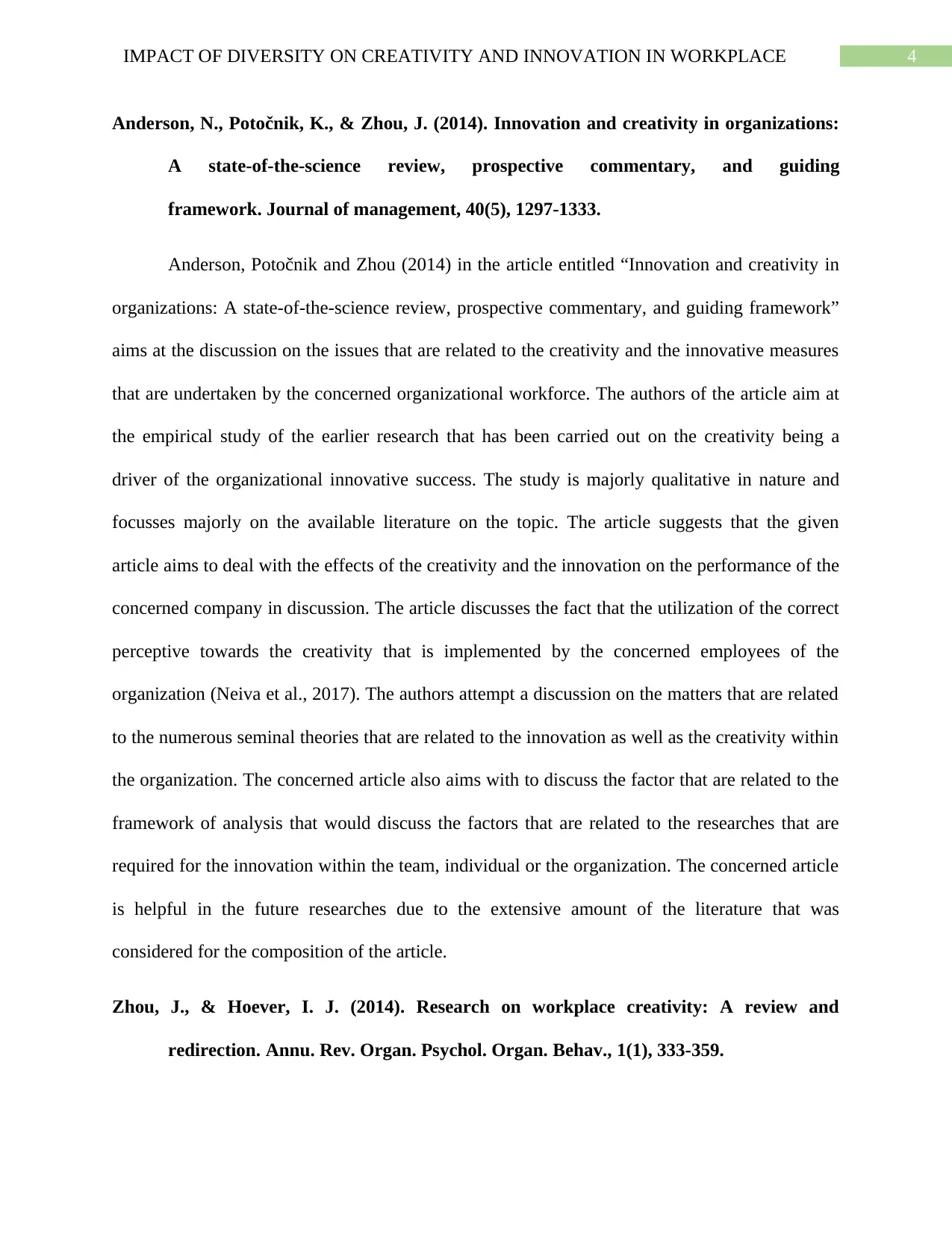
4IMPACT OF DIVERSITY ON CREATIVITY AND INNOVATION IN WORKPLACE
Anderson, N., Potočnik, K., & Zhou, J. (2014). Innovation and creativity in organizations:
A state-of-the-science review, prospective commentary, and guiding
framework. Journal of management, 40(5), 1297-1333.
Anderson, Potočnik and Zhou (2014) in the article entitled “Innovation and creativity in
organizations: A state-of-the-science review, prospective commentary, and guiding framework”
aims at the discussion on the issues that are related to the creativity and the innovative measures
that are undertaken by the concerned organizational workforce. The authors of the article aim at
the empirical study of the earlier research that has been carried out on the creativity being a
driver of the organizational innovative success. The study is majorly qualitative in nature and
focusses majorly on the available literature on the topic. The article suggests that the given
article aims to deal with the effects of the creativity and the innovation on the performance of the
concerned company in discussion. The article discusses the fact that the utilization of the correct
perceptive towards the creativity that is implemented by the concerned employees of the
organization (Neiva et al., 2017). The authors attempt a discussion on the matters that are related
to the numerous seminal theories that are related to the innovation as well as the creativity within
the organization. The concerned article also aims with to discuss the factor that are related to the
framework of analysis that would discuss the factors that are related to the researches that are
required for the innovation within the team, individual or the organization. The concerned article
is helpful in the future researches due to the extensive amount of the literature that was
considered for the composition of the article.
Zhou, J., & Hoever, I. J. (2014). Research on workplace creativity: A review and
redirection. Annu. Rev. Organ. Psychol. Organ. Behav., 1(1), 333-359.
Anderson, N., Potočnik, K., & Zhou, J. (2014). Innovation and creativity in organizations:
A state-of-the-science review, prospective commentary, and guiding
framework. Journal of management, 40(5), 1297-1333.
Anderson, Potočnik and Zhou (2014) in the article entitled “Innovation and creativity in
organizations: A state-of-the-science review, prospective commentary, and guiding framework”
aims at the discussion on the issues that are related to the creativity and the innovative measures
that are undertaken by the concerned organizational workforce. The authors of the article aim at
the empirical study of the earlier research that has been carried out on the creativity being a
driver of the organizational innovative success. The study is majorly qualitative in nature and
focusses majorly on the available literature on the topic. The article suggests that the given
article aims to deal with the effects of the creativity and the innovation on the performance of the
concerned company in discussion. The article discusses the fact that the utilization of the correct
perceptive towards the creativity that is implemented by the concerned employees of the
organization (Neiva et al., 2017). The authors attempt a discussion on the matters that are related
to the numerous seminal theories that are related to the innovation as well as the creativity within
the organization. The concerned article also aims with to discuss the factor that are related to the
framework of analysis that would discuss the factors that are related to the researches that are
required for the innovation within the team, individual or the organization. The concerned article
is helpful in the future researches due to the extensive amount of the literature that was
considered for the composition of the article.
Zhou, J., & Hoever, I. J. (2014). Research on workplace creativity: A review and
redirection. Annu. Rev. Organ. Psychol. Organ. Behav., 1(1), 333-359.
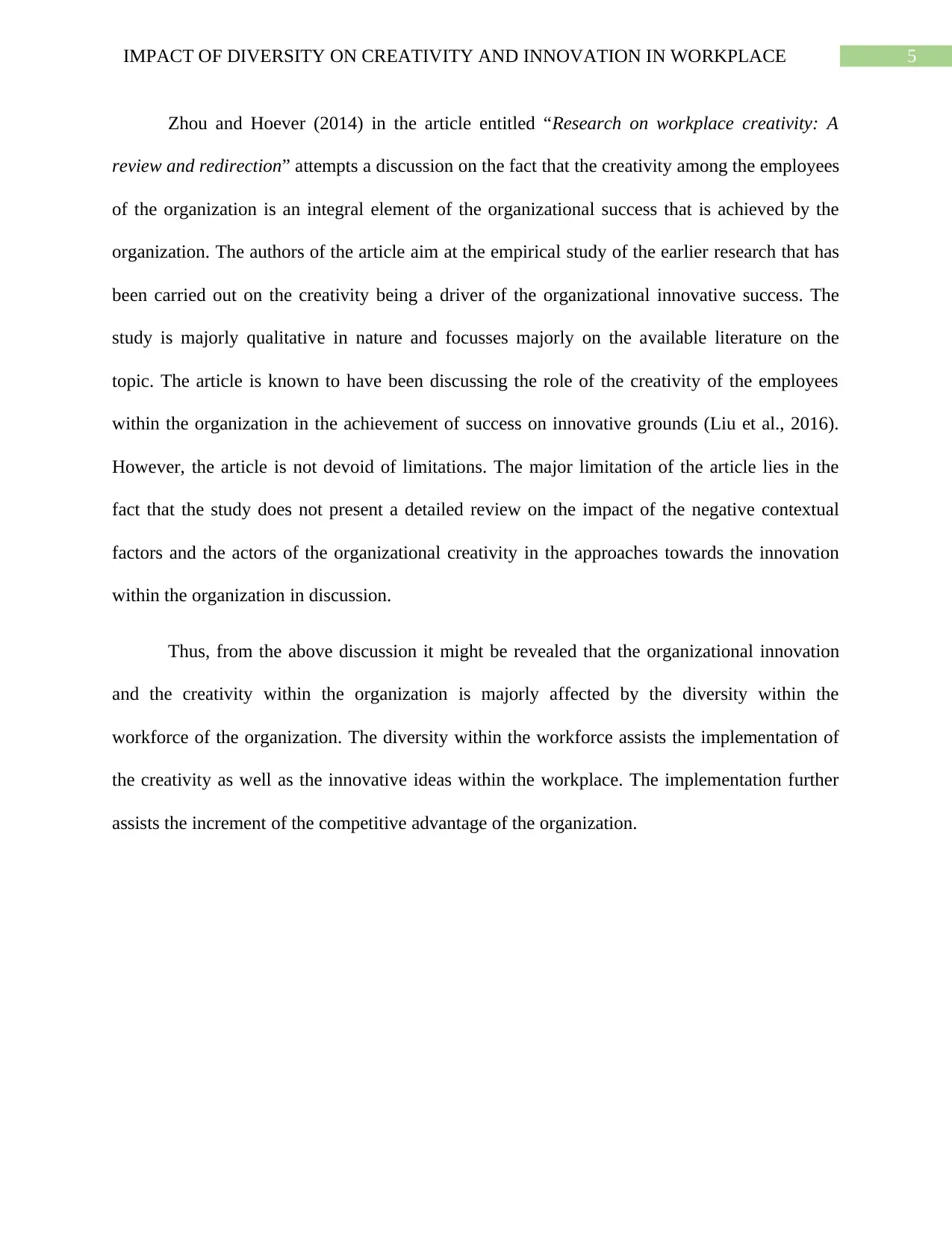
5IMPACT OF DIVERSITY ON CREATIVITY AND INNOVATION IN WORKPLACE
Zhou and Hoever (2014) in the article entitled “Research on workplace creativity: A
review and redirection” attempts a discussion on the fact that the creativity among the employees
of the organization is an integral element of the organizational success that is achieved by the
organization. The authors of the article aim at the empirical study of the earlier research that has
been carried out on the creativity being a driver of the organizational innovative success. The
study is majorly qualitative in nature and focusses majorly on the available literature on the
topic. The article is known to have been discussing the role of the creativity of the employees
within the organization in the achievement of success on innovative grounds (Liu et al., 2016).
However, the article is not devoid of limitations. The major limitation of the article lies in the
fact that the study does not present a detailed review on the impact of the negative contextual
factors and the actors of the organizational creativity in the approaches towards the innovation
within the organization in discussion.
Thus, from the above discussion it might be revealed that the organizational innovation
and the creativity within the organization is majorly affected by the diversity within the
workforce of the organization. The diversity within the workforce assists the implementation of
the creativity as well as the innovative ideas within the workplace. The implementation further
assists the increment of the competitive advantage of the organization.
Zhou and Hoever (2014) in the article entitled “Research on workplace creativity: A
review and redirection” attempts a discussion on the fact that the creativity among the employees
of the organization is an integral element of the organizational success that is achieved by the
organization. The authors of the article aim at the empirical study of the earlier research that has
been carried out on the creativity being a driver of the organizational innovative success. The
study is majorly qualitative in nature and focusses majorly on the available literature on the
topic. The article is known to have been discussing the role of the creativity of the employees
within the organization in the achievement of success on innovative grounds (Liu et al., 2016).
However, the article is not devoid of limitations. The major limitation of the article lies in the
fact that the study does not present a detailed review on the impact of the negative contextual
factors and the actors of the organizational creativity in the approaches towards the innovation
within the organization in discussion.
Thus, from the above discussion it might be revealed that the organizational innovation
and the creativity within the organization is majorly affected by the diversity within the
workforce of the organization. The diversity within the workforce assists the implementation of
the creativity as well as the innovative ideas within the workplace. The implementation further
assists the increment of the competitive advantage of the organization.
⊘ This is a preview!⊘
Do you want full access?
Subscribe today to unlock all pages.

Trusted by 1+ million students worldwide

6IMPACT OF DIVERSITY ON CREATIVITY AND INNOVATION IN WORKPLACE
References
Anderson, N., Potočnik, K., & Zhou, J. (2014). Innovation and creativity in organizations: A
state-of-the-science review, prospective commentary, and guiding framework. Journal of
management, 40(5), 1297-1333.
Bouncken, R., Brem, A., & Kraus, S. (2016). Multi-cultural teams as sources for creativity and
innovation: The role of cultural diversity on team performance. International Journal of
Innovation Management, 20(01), 1650012.
Guillaume, Y. R., Dawson, J. F., Otaye‐Ebede, L., Woods, S. A., & West, M. A. (2017).
Harnessing demographic differences in organizations: What moderates the effects of
workplace diversity?. Journal of Organizational Behavior, 38(2), 276-303.
Lambert, J. (2016). Cultural diversity as a mechanism for innovation: Workplace diversity and
the absorptive capacity framework. Journal of Organizational Culture, Communications
and Conflict, 20(1), 68.
Liu, D., Jiang, K., Shalley, C. E., Keem, S., & Zhou, J. (2016). Motivational mechanisms of
employee creativity: A meta-analytic examination and theoretical extension of the
creativity literature. Organizational behavior and human decision processes, 137, 236-
263.
Moyano, M. (2016). Cultural Intelligence in Organizational Contexts and Human Resource
Management. In Strategic Labor Relations Management in Modern Organizations (pp.
121-134). IGI Global.
References
Anderson, N., Potočnik, K., & Zhou, J. (2014). Innovation and creativity in organizations: A
state-of-the-science review, prospective commentary, and guiding framework. Journal of
management, 40(5), 1297-1333.
Bouncken, R., Brem, A., & Kraus, S. (2016). Multi-cultural teams as sources for creativity and
innovation: The role of cultural diversity on team performance. International Journal of
Innovation Management, 20(01), 1650012.
Guillaume, Y. R., Dawson, J. F., Otaye‐Ebede, L., Woods, S. A., & West, M. A. (2017).
Harnessing demographic differences in organizations: What moderates the effects of
workplace diversity?. Journal of Organizational Behavior, 38(2), 276-303.
Lambert, J. (2016). Cultural diversity as a mechanism for innovation: Workplace diversity and
the absorptive capacity framework. Journal of Organizational Culture, Communications
and Conflict, 20(1), 68.
Liu, D., Jiang, K., Shalley, C. E., Keem, S., & Zhou, J. (2016). Motivational mechanisms of
employee creativity: A meta-analytic examination and theoretical extension of the
creativity literature. Organizational behavior and human decision processes, 137, 236-
263.
Moyano, M. (2016). Cultural Intelligence in Organizational Contexts and Human Resource
Management. In Strategic Labor Relations Management in Modern Organizations (pp.
121-134). IGI Global.
Paraphrase This Document
Need a fresh take? Get an instant paraphrase of this document with our AI Paraphraser
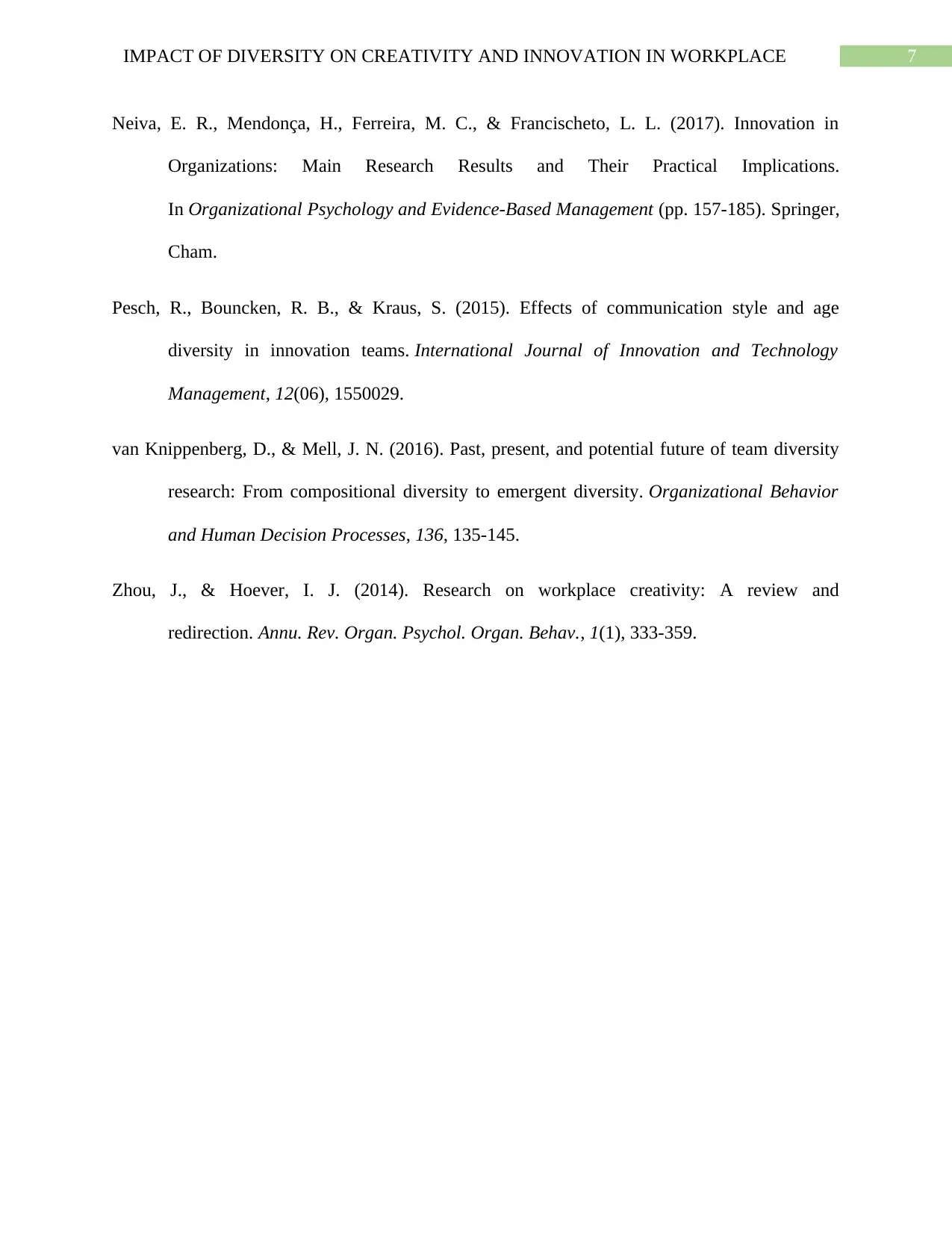
7IMPACT OF DIVERSITY ON CREATIVITY AND INNOVATION IN WORKPLACE
Neiva, E. R., Mendonça, H., Ferreira, M. C., & Francischeto, L. L. (2017). Innovation in
Organizations: Main Research Results and Their Practical Implications.
In Organizational Psychology and Evidence-Based Management (pp. 157-185). Springer,
Cham.
Pesch, R., Bouncken, R. B., & Kraus, S. (2015). Effects of communication style and age
diversity in innovation teams. International Journal of Innovation and Technology
Management, 12(06), 1550029.
van Knippenberg, D., & Mell, J. N. (2016). Past, present, and potential future of team diversity
research: From compositional diversity to emergent diversity. Organizational Behavior
and Human Decision Processes, 136, 135-145.
Zhou, J., & Hoever, I. J. (2014). Research on workplace creativity: A review and
redirection. Annu. Rev. Organ. Psychol. Organ. Behav., 1(1), 333-359.
Neiva, E. R., Mendonça, H., Ferreira, M. C., & Francischeto, L. L. (2017). Innovation in
Organizations: Main Research Results and Their Practical Implications.
In Organizational Psychology and Evidence-Based Management (pp. 157-185). Springer,
Cham.
Pesch, R., Bouncken, R. B., & Kraus, S. (2015). Effects of communication style and age
diversity in innovation teams. International Journal of Innovation and Technology
Management, 12(06), 1550029.
van Knippenberg, D., & Mell, J. N. (2016). Past, present, and potential future of team diversity
research: From compositional diversity to emergent diversity. Organizational Behavior
and Human Decision Processes, 136, 135-145.
Zhou, J., & Hoever, I. J. (2014). Research on workplace creativity: A review and
redirection. Annu. Rev. Organ. Psychol. Organ. Behav., 1(1), 333-359.
1 out of 8
Related Documents
Your All-in-One AI-Powered Toolkit for Academic Success.
+13062052269
info@desklib.com
Available 24*7 on WhatsApp / Email
![[object Object]](/_next/static/media/star-bottom.7253800d.svg)
Unlock your academic potential
Copyright © 2020–2025 A2Z Services. All Rights Reserved. Developed and managed by ZUCOL.





